Please note that the aim of this article is not to determine whether barefoot or shod is superior, as both have their positives and negatives based on the horses past husbandry practice and use, and serious hoof deformities can occur in either case if the approach to hoof care is not optimal. Instead, the article focuses on presenting specific facts, details, and comparisons to provide a clearer understanding of the hoof and the root causes of hoof deformities in general, with the goal of preventing such deformities in both barefoot and shod horses.
What are the parameters of a healthy hoof? Different sources provide slightly different data and the ideas of the proponents of individual methods therefore differ slightly. One thing is a list of parameters in form of numbers, the other is what can be observed from the anatomy of the horse and detailed, longterm observation of the hooves with help of photography. To make things simple, I am including a few comparative photos here for your reference, where I believe that the proponents of various methods would agree on what is a rather healthy hoof and what is a rather deformed and diseased hoof. Even without using numbers.
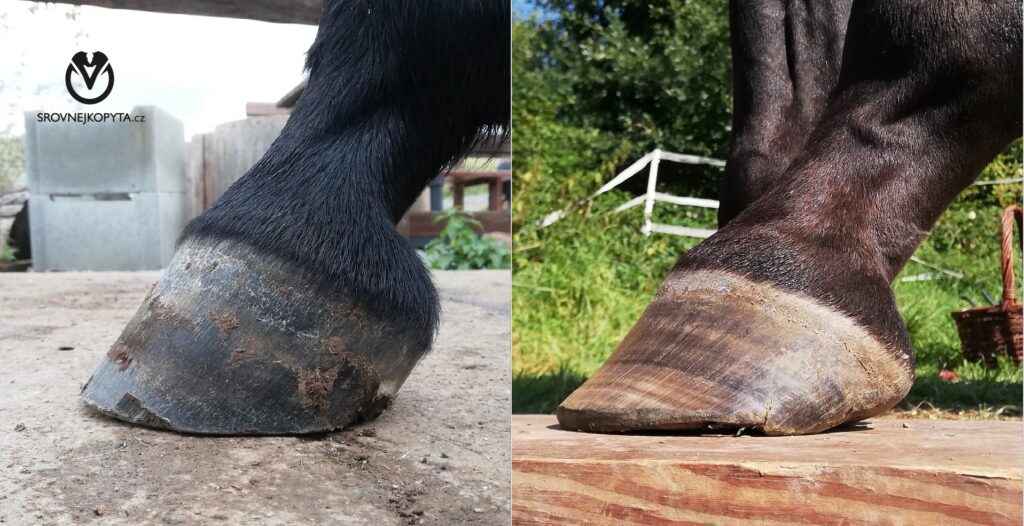
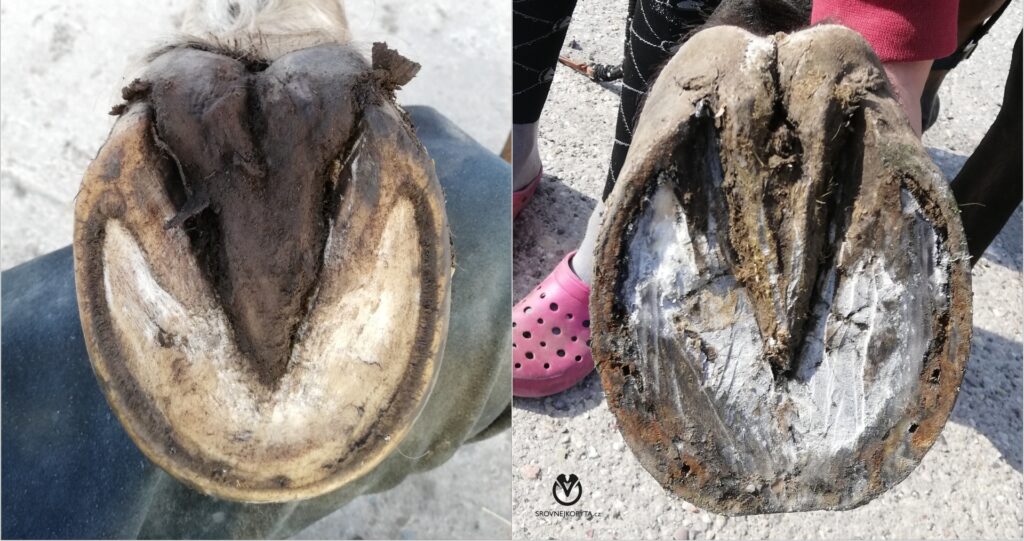
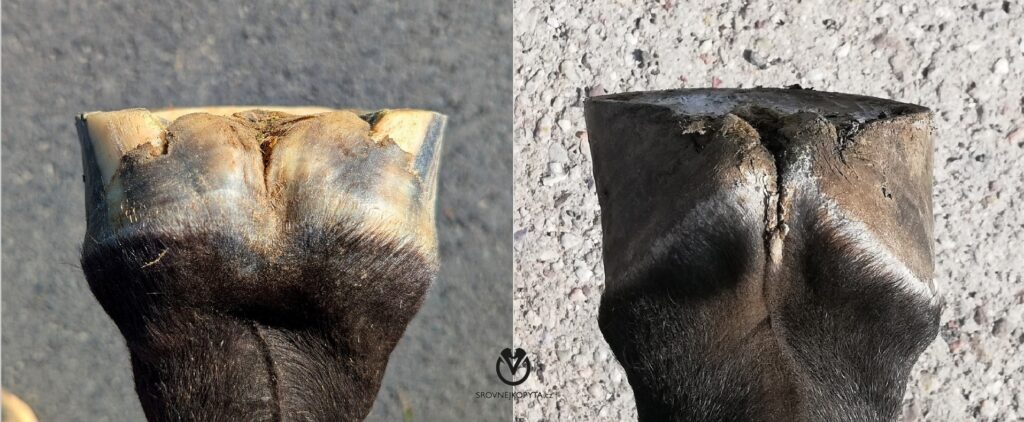
Let’s not look at the ideal hoof just by numbers and angles at this point. These are certainly important in detailed scientific research, but let’s try to involve more our senses, which can be more important than precise measurements when assessing hoof health from the perspective of the average horse owner. Fixating on precise numbers and angles can sometimes be misleading and cause unnecessary contradictions. I conclude that the ideas about a healthy hoof are more or less similar in all available methods and they try to achieve similar parameters. However, they differ in the perception of details and in the beliefs about how to help the hoof achieve functional parameters (some leave higher heels, some trim the frog during every trim, some don´t etc). This different perception and subsequent prioritization of adjustments to specific parts of the hoof over other parts can be reflected in the result and in long-term application.
In addition to the traditional farrier method, there are other available methods of trimming horse hooves. These methods are in most cases based on the observation of feral horses (primarily Pete Ramey, David Landreville, Jamie Jackson, Hiltrud Strasser and others). I will not describe in detail the exact procedures of the individual methods, nor will I compare them at lengt here in this article. You can find a brief description and comperison of few method in the section P3trim. More details will be included in the Patreon online course. It is definitely useful exercise to search for the description of the individual methods on the respective websites of other trimmers and farriers who are using those methods and its better if you read about them yourself, to form your own first hand opinion.
Its interesting to observe that discussions between supporters of different methods and opinions very often lead nowhere, because preconceived ideas, traditional practices, beliefs and assumptions are very ingrained and arouse emotions that influence any discussion rather unproductively. This is, however, human nature. Therefor due to above stated, I stretch the necesstity of providing evidence. To have a productive and meaningful discussion about trimming and shoeing methods, it is essential for all participants to dedicate sufficient time to one another and present long-term evidence. Those unwilling to take this approach or unable to provide evidence often resort to making unsupported arguments, which add little value to the conversation.
Given the abundance of unsubstantiated claims on this topic, those who genuinely aim to help horse owners make informed decisions must prioritize objective evidence. Such evidence should offer a degree of proof and a clear methodology, enabling others to test and evaluate the trimming methods and its outcomes for themselves.
In the long term, the collected case studies should help us to make more precise and objective assessments. Observing and comparing the results of various hoof trimming and shoeing methods over a longer period of time and their effect on the movement of horses on various surfaces is the goal of this website. The longer the owners are willing to monitor and document their horses‘ hooves, the more objective and qualitative the evaluation will be.
On this website, I will not attempt to provide a strict definition or description of a healthy hoof. Instead, I aim to present here and also in the online course on Patreon, as simply as possible, my understanding (based on my experience from trimming and my research) of the relationships between the key anatomical structures and their functions and how it is supported by scientific research. From this perspective, it should become clear which hoof shape is most likely to support long-term health and functionality. As horse owners, this approach will help you grasp the core principles of hoof care rather than relying solely on exact measurements or specific angles. By understanding these foundations, you can make informed decisions about your horse’s hoof health.
To dive deeper into this topic, read further and later visit the P3Trim section.
The most common deformations and defects of the hoof capsule
I commonly observe the following deformations of horses hooves all around the world, including the feral horses living in specific regions. Their occurrence often causes cracking of the hoof wall, abscesses or deterioration in the horses movement.
- Contracted heels
- Caudal failure
- Thrush
- Uneven heels
- Underrun heels
- Overgrown front wall, flare on the front wall, the lower half of the front wall is not growng tightly along the coffin bone
- Pushed-up coronet
- Flat foot
- Laminitis
Illustrative examples
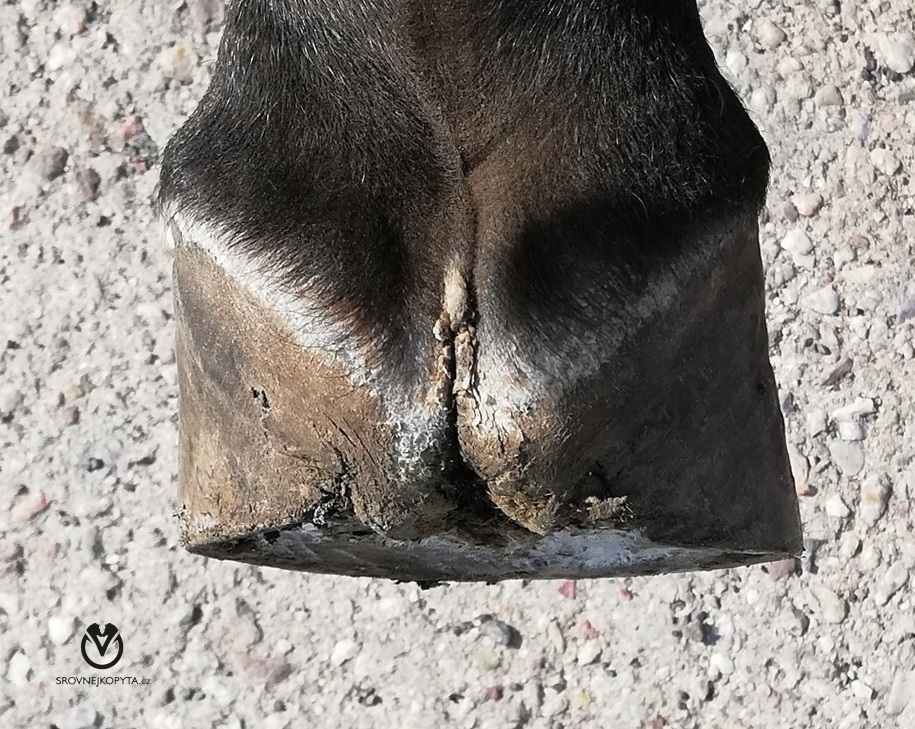
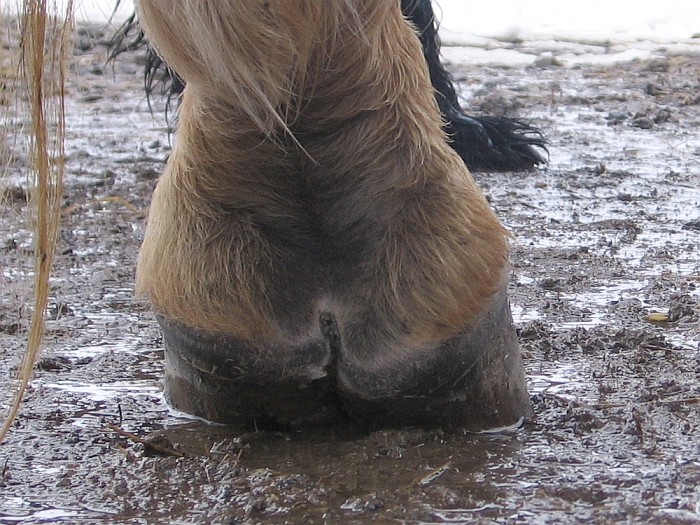
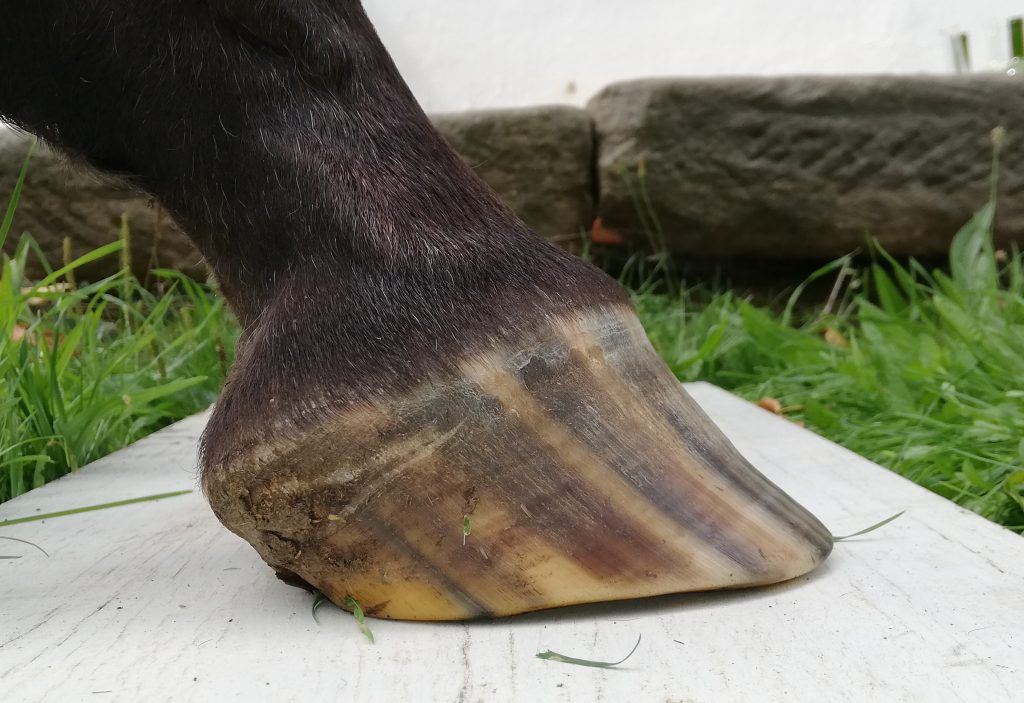
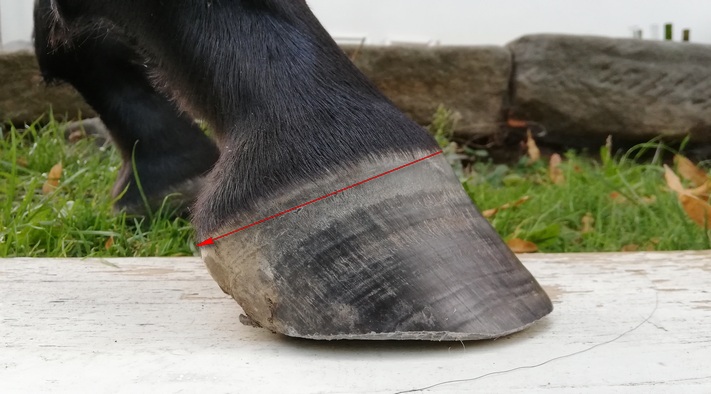
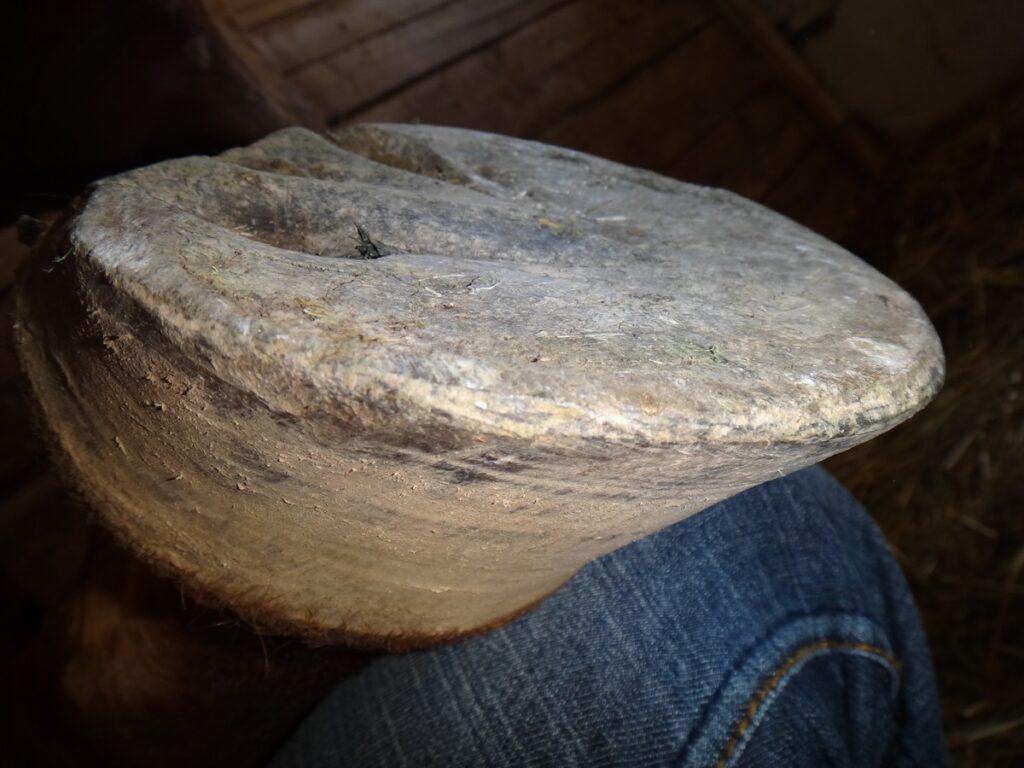
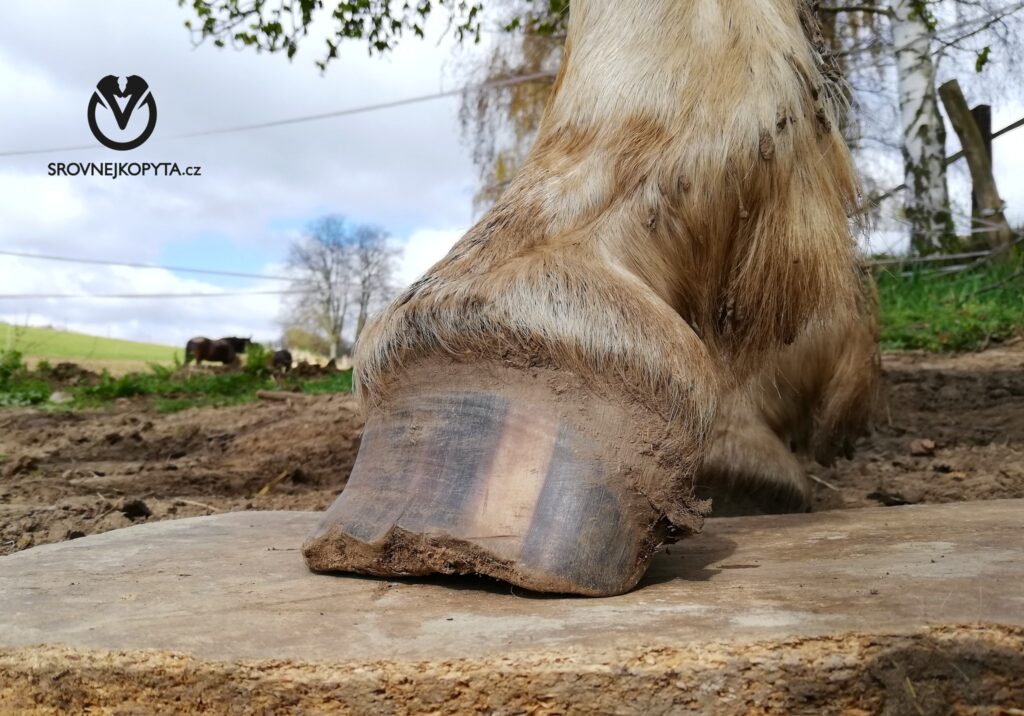
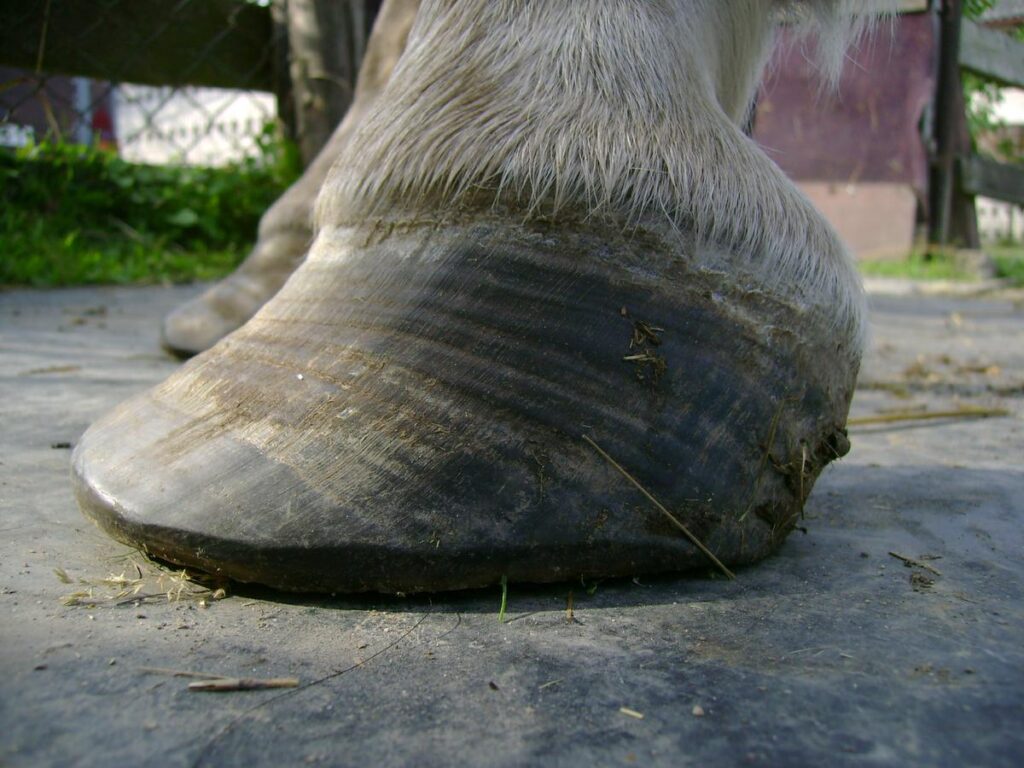
Can a deformed hoof be returned to its physiological and functional shape?
My case studies and case studies of many proffesionals from all around the world show, that most of these deformations can be prevented, or if already present on the hooves, rehabilitated. Case studies and updated trimming protocols are typically compiled and shared by dedicated individuals—horse owners, veterinarians and farriers—who are deeply committed to improving equine welfare and health care. These professionals often work with horses primarily used for entertainment and recreation. One significant advantage of recreational horses is the lack of economic pressure, allowing for a greater focus on their well-being. These professionals often have long-term access to a large number of horses, providing them with valuable opportunities to gain practical experience. Combined with their education in the field, this access enables them to experiment and refine their methods over time. They can describe the anatomy of the hoof in great detail, thanks to long-term observation, cooperation, trial and error and repeated testing, determine the origin of the deformations and verify the proposed solutions. These methods come to the same conclusions, that the above-mentioned deformations are often related. They first appear individually and over time some of the others listed are added. With long-term monitoring of dysfunctional hooves, it is possible to determine quite well the connections between individual deformations, their causes and the timing of their occurrence.
On the contrary, most farriers don´t monitore their work long term. It is also worth noting that the traditional farriery approach comes from the times when the horses helped men survive. The need to protect the horse’s hooves prevailed, when standing for a long time in a dirty stable, during daily strenuous work or when moving a military horse in rugged terrain. Very often putting a horse out of service for health reasons could endanger the life of an entire family or community. It is very likely that human interests often completely outweighed interests in the well-being and detailed condition of the animal. The main motive in the case of hoof problems could have been to bring a dysfunctional hoof into a serviceable state so that the animal could continue serving as long as possible. Is it possible that this approach has remained rooted in the farriery method (and perception of horse owners) to this day? Many observations indicate this and relate especially to horses used for sports, where the need for survival has transformed into the need to compete, win and gain profit. I have no doubt that many farriers do their job very well, with the best intentions, to help the horse walk well or improve the condition of a sick hoof. However, it is unclear whether the origins of this profession might, in some cases, limit the understanding of how hoof deformities develop and how they are addressed today. Too often I see both shod and barefoot horses with very contracted heels, extremely low underrun heels and no attempts made to correct these conditions during trimming and re-shoeing cycles. On the contrary, these conditions are often considered genetically determined and unchangeable. It is not even possible to determine with certainty the proportion of work of skilled and experienced farriers compared to poor-quality adjustments, because most farriers do not have time or dont want to photograph their work. There is almost no evidence available in the Czech republic. The evaluation of the work of a farrier is in the hands of individual horse owners, who are often not educated in this issue and so many horse owners find themselfs in a vicious circle. Sometimes the owner avoids asking questions out of fear that the farrier would stop attending to their horses.
Besides that scientific studies have already pointed out in the past the risks of possible destructive influnce of classic steel horseshoe on the hoof (Clark 1809, see Information hub section). Especially when the reshoeing intervals exceed 6 weeks. It limits the mechanics of the hoof and thus the blood supply, burdens the musculoskeletal system, and when it hits a hard surface, it resonates at a frequency of around 800Hz, which is a frequency that damages living tissue and first of all the finest capillaries. Thanks to nails, the hoof wall is damaged and the thermal protection of the hoof deteriorates. The metal shoe itself, unsuitable terrain, lack of exercise, dried horn, poor hoof care and especially leaving the shoe on the hoof for more than 6 weeks are the most common causes of hoof deformation, poor-quality slowly growing horn and long-term damage to hoof structures.
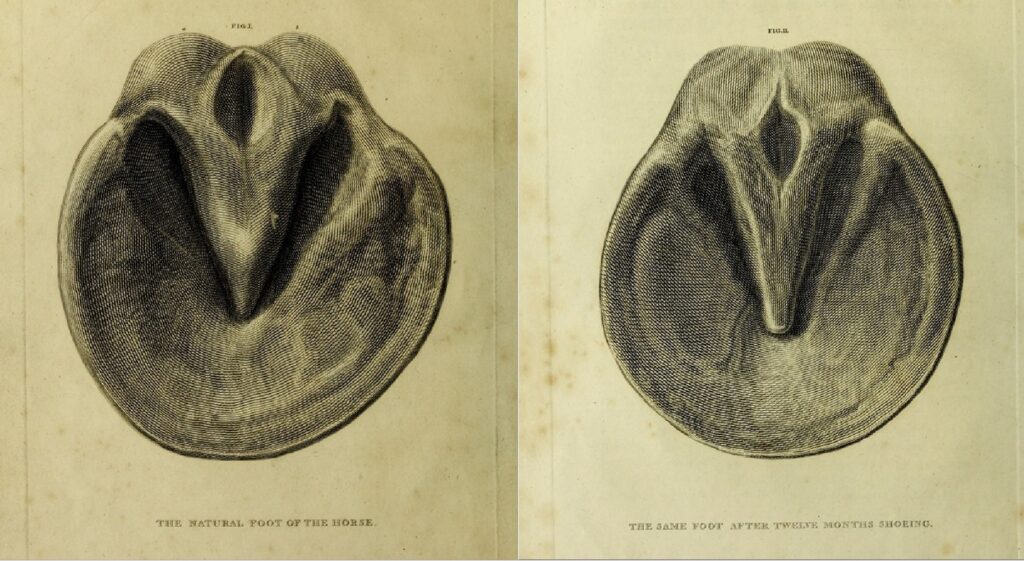
In the correction of hoof deformities, experience shows that many farriers and horse owners still tend to believe that most hoof deformities are inevitable or even congenital and that the application of horseshoes is necessary to minimize or treat these deformities. Here, the results are completely at odds with the barefoot methods of trimming and the longterm photographic evidence brings important proofs. Let us not be mistaken. Also, any misunderstood or insufficiently performed barefoot trimming, whether by farrier pasture trim or one of the trimming methods based on the feral horse model, can result in serious deformations, even without horseshoes.
The common denominator of most deformed hooves of domesticated horses is a lack of understanding and monitoring of what happens when something on the hoof is shortened too much or left too long compared to the physiological state over a long period of time. Instead of the hoof being stimulated and strengthened by contact with the ground, it gradually deforms and develops an unphysiological shape that is unable to fulfill its original function.
If, for example, we repeatedly remove too much of the sole horn, we can promote the development of a weak sole that is not resistant to point pressure, i.e. stepping on a stone (symptoms include, for example, crumbling gait, stumbling, general reluctance to walk, abscesses). If, on the other hand, we repeatedly let part of the hoof wall or the entire hoof wall overgrow, over time it will become apparent because the weight of the horse and the counterpressure of the ground are too great (cracking of the hoof wall, underrun heels, etc.).
What are the important reference points and what turns out to be important?
Most hoof deformations and diseases arise, simply put, from longterm overloading of the hoof walls and lack of sole and frog stimulation. Long intervals between trims give the horse no other option than walk on the overgrown hoof walls, which triggers unwanted changes to the hoof capsule. The hoof is then subjected to lever effect from various sides, deforming the hoof capsule, which subsequently compresses the internal structures and triggers various undesirable processes (stretching of the lamellar connection, thrush of the frog etc.).
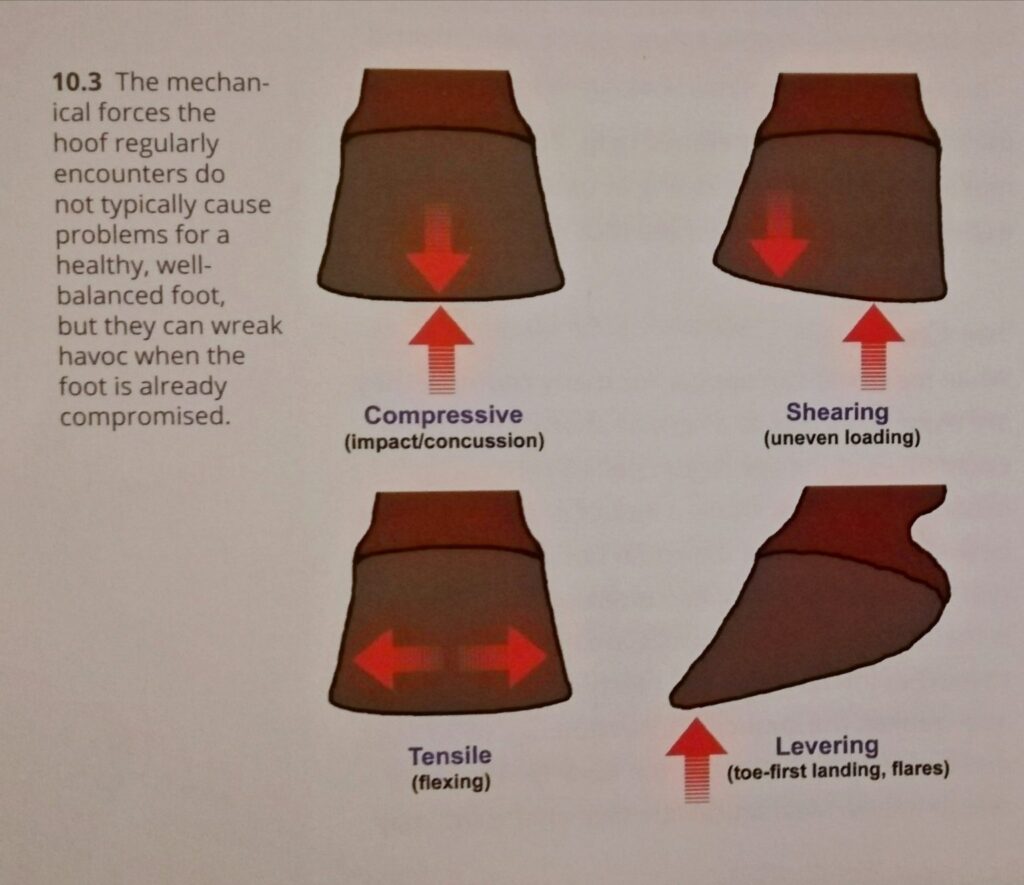
I would like to list a few factors that, after examining various methods from my experience so far, I personally consider to be essential and can serve as useful guidelines. When they are put into practice over a long period of time, it turns out that horses move very well on various terrain and show no or only minor deformations (which can be corrected) or hoof diseases.
Position of the coffin bone
When we imagine a horse standing on a flat surface with its weight exerting downward forces on its limbs, it seems logical to conclude that the plane of the coffin bone should ideally be parallel to the ground or exhibit only a slight positive palmar angle, since this bone has relatively sharp edges along its circumference and any rotation of the edges towards the ground surface contributes to the undesirable distribution of the forces acting on the surrounding structures. In practice, this means, for example, that the heels must not be too high or too low. In relation to what? In relation to the plane of the functional sole. The horn of the sole grows from the connective tissue at the bottom of the coffin bone. If left untouched, the layer of the live waxy sole horn is spread evenly along the bottom of the coffin bone and copies its shape, creating the concavity of the sole that we see on the outside. Therefor the sole can be considered an important reference point. If we shorten the hoof walls to the level of the sole with each trim, we will ensure that the plane of the coffin bone is parallel or closely paralell to the ground. There are few exceptions which I will be describing in more depth in the Patreon online course.
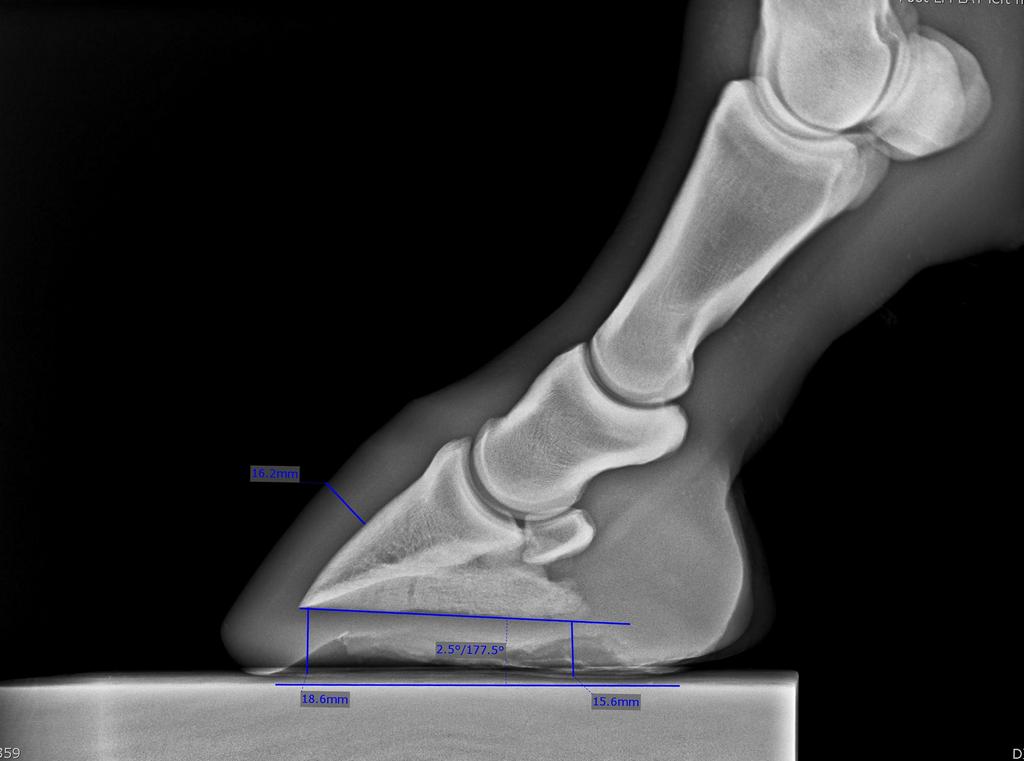
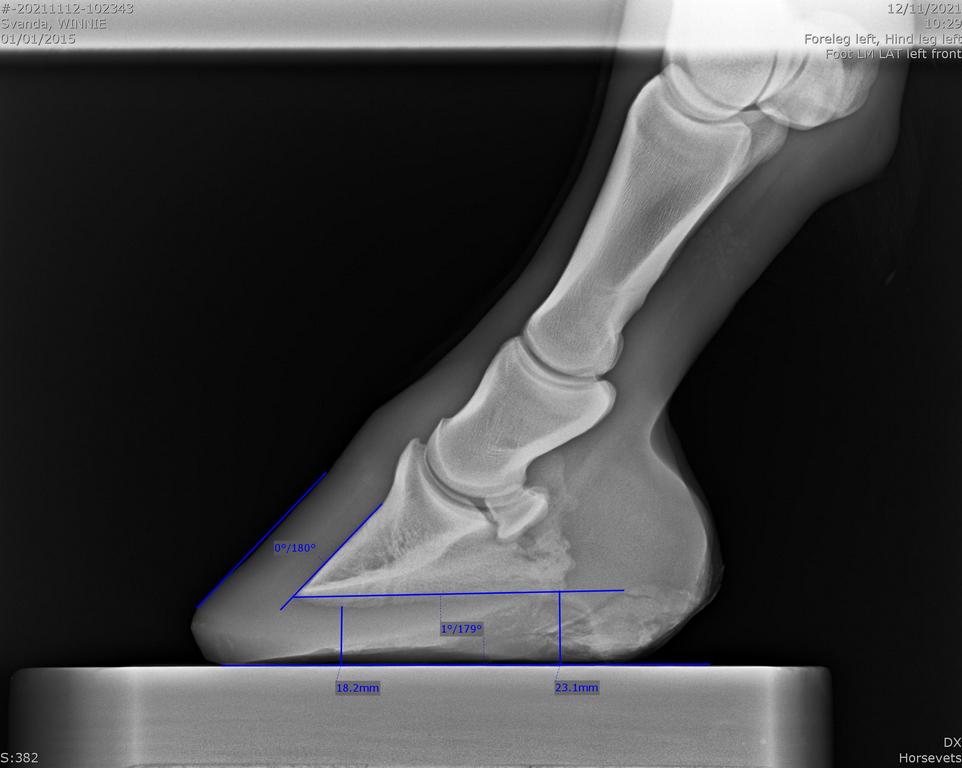
Hoof capsule
If the hoof capsule is to fulfill its protective and partially load-bearing function, it should fit tightly and as precisely as possible (with the lamellae) to the coffin bone and copy its shape (from the sides and from below). Each horse may have a slightly different shape of the coffin bone and, therefore, a unique shape to its physiological hoof capsule. Yet all such hooves can be functional and healthy. It is necessary to learn to recognize the signs that indicate that the hoof capsule is disturbed. Monitoring the different structures of the hoof will help us to do this.
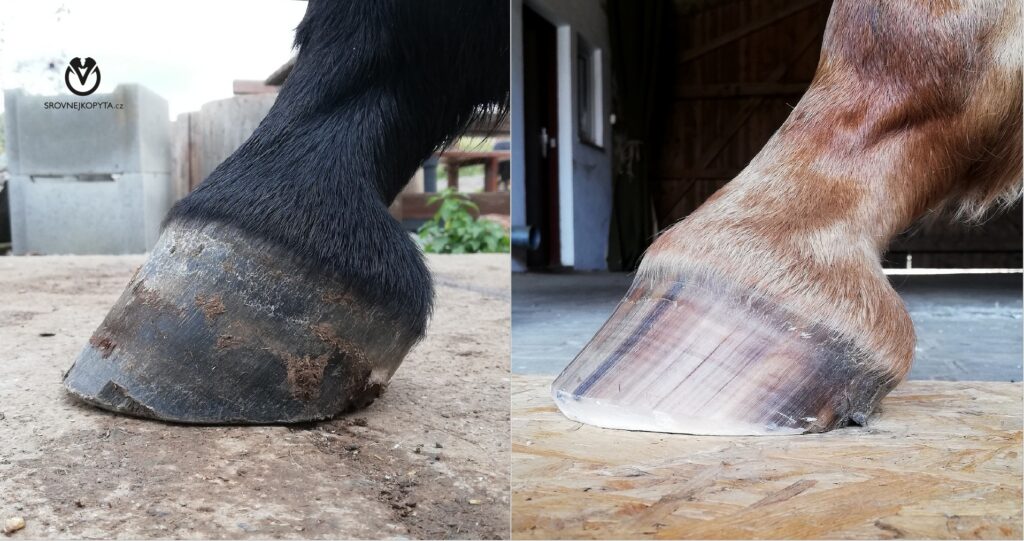
Hoof walls – experience shows that they are not the only load-bearing part of the hoof as original believed by many hoofcare professionals. If they are overgrown somewhere and are loaded for a long time, they deform. It helps to observe the line of the coronet or whether flares or cracks form on the capsule. If we detect such defects, it is a sign that the hoof walls have been excessively overloaded for a long time. As mentioned before the sole plane provides us with an important indicator that shows us how much the hoof wall is overgrown. When we learn to distinguish a real sole from the „fake“ one (overlaid bars, layers and numbs of exfoliating sole), this plane will provide us with an important reference point (Uniform sole thickness method, source M.R. Savoldi and G.F. Rosenberg, see Information hub section) and it will be clear how much hoof wall to trim.
Bars – I consider them the biggest challenge in understanding the part of the hoof capsule. Experience so far shows me that if the bars do not grow upright, it will start to lie down at some point on its white line and its horn will gradually begin to overlap the horn of the sole (this usually happens hand in hand with deformations of the outer hoof walls – flaring). This is usually not visible to the naked eye, although sometimes it is indicated by the fact that the foot is not concave and is filled with horn. It turns out that in certain cases the bars can cover the entire sole and thus prevent its intensive stimulation by the surface on which the horse walks. I am inclined to the fact that the bars should be regulary trimmed and its crawling should be prevented. This way, they fulfill a supporting function in the heel area, where they create strong and durable so-called hard heels, which the horse with physiological hooves steps on first. At the same time, the bars in this form also work against slipping. Some methods of barefoot trimming, inspired by feral horses hooves, state that crawling bars can indicate that the foot is weak and by crawling on weak sole, it protects th sole. In very dysfunctional hooves, this is part of the rehabilitation process – to leave the crawling bars without trimming. I prefer to prevent any crawling of bars. If the true horn of the sole has the ability to grow stronger and thicker, why prolong this adaptation process by growing bars and then removing them much later (the whole process can take up to 2 years). Horse with very thin soles should be ideally kept on soft surfaces during the initial phases of rehabilitation and thereby the crawling bars can be trimmed and its growth returned to their designated physilogical location.
The sole – it is essential that it is sufficiently concave and strong. The hoof capsule (hoof walls and sole) serves primarily to protect the soft structures inside the hoof. Given the weight of the horse and the way it moves in the landscape, I see the sole as the most vulnerable part. What happens if a horse with a thin flat sole steps on a stone? A thin sole will not allow the distribution of point pressure over the entire surface and, on the contrary, the point pressure will press intensively in one spot, causing a greater or lesser bruise. If the foot is thick and concave, the point pressure is dispersed over the entire surface and the horse has the opportunity to escape without harm. The thick sole also serves as a solid base and support for the coffin bone. It is known that even if a part of the hoof peripheral wall is removed from a horse, the horse is still able to move on the foot. However, if part of the sole is injured or removed, the horse will start to limp or stop walking altogether. Whether the sole is sufficiently developed can be determined either by pressing the sole around the tip of the frog or by measuring the depth of the grooves at the frog apex and in its deepest point at the level of the heels (Ramey). The most objective way is to do X -rays. Practice, dissection and observation show that if the distance between the deepest point of the groove at the level of the heels / the ground (using the rasp placed flat on the foot) is about 2.5 cm and at the tip about 1.8 cm, the foot is sufficiently concave and therefore thick and fulfills an excellent protective function. The horse is able to move without consequences (lameness, abscess, etc.) even over rocky terrain at a trot or gallop.
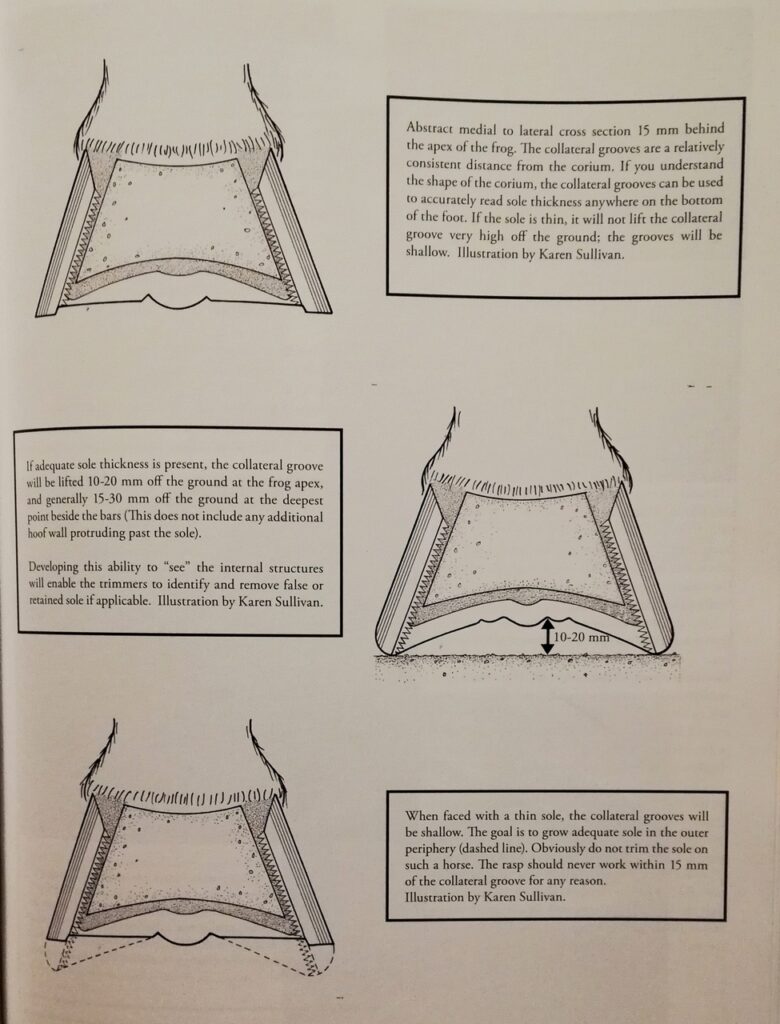
https://www.hoofrehabstore.com/care-and-rehab-of-the-equine-foot/
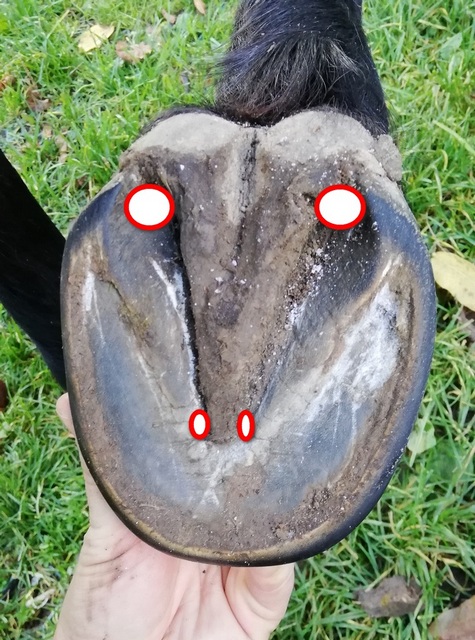
Frog
The frog absorbs impact vibrations and has an anti-slip effect. For its healthy development, it needs close contact with the ground, movement and “clean” dirt, i.e. natural mud and ground surfaces without a large admixture of feces or urine. If we meet these requirements, there is no need to trim the frog at all. Its surface is regularly replaced a few times a year. The old structure will begin to loosen and fall off. As Pete Ramey writes in his book Care and Rehabilitation of the Equine Hoof: “As with the foot, the most common approach to trimming the frog should be to do NOTHING to it.”
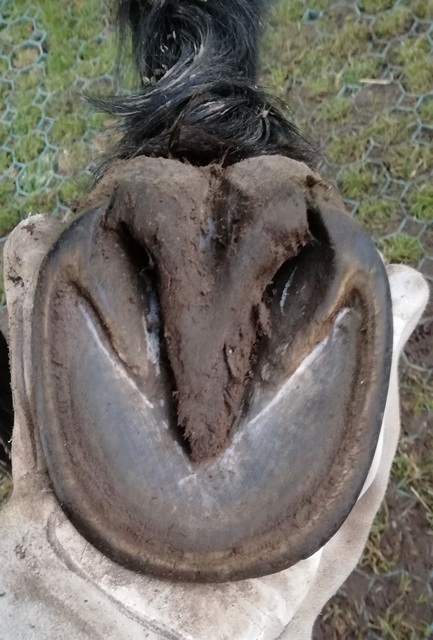
Conclusion
The more I learn to observe, perceive and recognize these factors, the more it helps me in my ability to visualise the internal structures of the hoof while looking on the external structures, identify deformations of the hoof capsule that are undesirable and choose a procedure that leads to correction and healthy movement of the horse.
The information and observations I have gathered so far convinced me to lean towards hoof trimming methods inspired by the model of feral horses that move on rocky and sandy surfaces, where the emphasis is on a strong and well-developed live sole without crawling bars. If I were to simply define physiological trim, I would highlight these points, which I believe are (together with sufficient amount of movement and balanced diet) the essence of hoof health from foal age, because if you stick to them, most hoof deformities and pathologies (as my case studies show) are naturally prevented and eliminated:
- the hoof walls grow adjacent and along the coffin bone and internal structures
- the hoof has a strong sole capable of withstanding point pressure (stones and other irregularities of the terrain, sole thickness 12 mm and more in middle sized and big breeds)
- as result: the coffin bone plane is almost parallel to the ground (palmar angle 1-3 degrees)
- the pastern axis is almost in straight line (not broken forward or back)
- the shock absorbing structures are well developed and functional
As for hoof protection, I am inclined to using boots and further forms of shoeing, where the shoe allows sufficient stimulation of the sole, frog and heel flexibility and is changed at intervals of up to 6 weeks at the longest. A strong argument for these approaches is their ability to maintain hooves as close to their physiological and functional shape as possible while being able to explain the causes of hoof deformities. They also demonstrably ensure correction, which is very often not achieved through traditional farriery methods such as pasture trims, metal shoes, and long trimming and reshoeing intervals.
If a horse owner chooses a traditional shoeing for his horse with a simple metal horseshoe, he should, in my opinion, consistently require frequent reshoeing so that the horse does not overload the hoof walls and include barefoot periods so that the hoof and the associated parts of the body have the opportunity to regenerate.
I welcome cooperation of horse owners and proponents of individual methods in collecting useful photographic documentation of hoof rehabilitation and experiences with the resulting movement of horses on various surfaces, with which we can in the future understand even more the abilities of adaptation and the processes of hoof changes and contribute to maximum extent to the development of healthy hooves in horses.
“Physiological trim is such a trim that allows the tissues of the foot to function optimally in dispersing impact energies during foot contact with the ground.”
Dr. R. Bowker